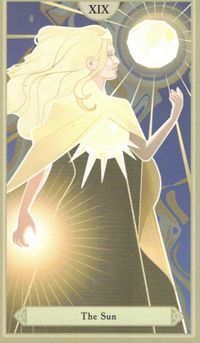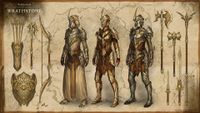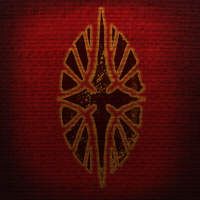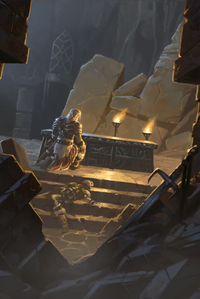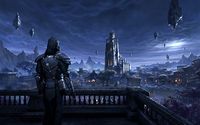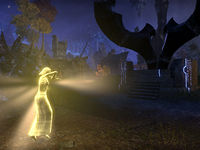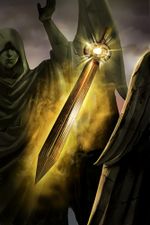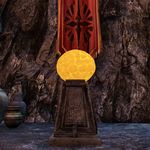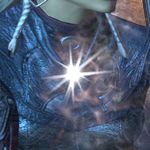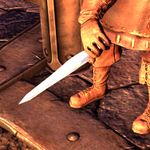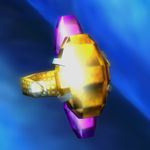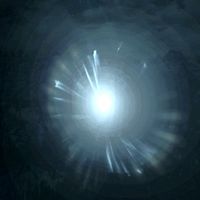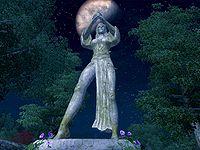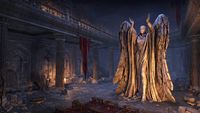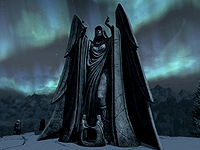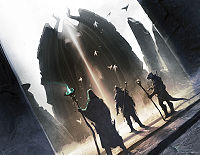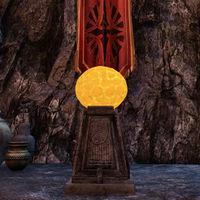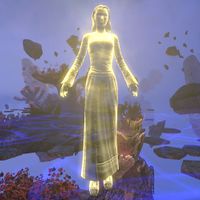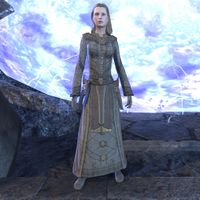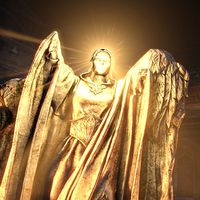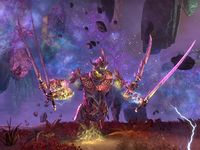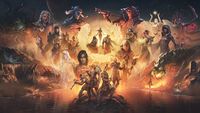Lore:Meridia
—Meridia
Meridia, Lady of Infinite Energies,[1] the Bright Lady,[2] the Strict but Fair Arbiter of Inner Luminance,[3] the Sunfire,[4] the Radiant One,[5] the Keeper,[6]:14 the Lady of Light,[7][8]:293 the Red Star, the Harbinger of Dawn, Goddess Who Holds, Mirror of the Lie[9] and the Prince of Life[10] is the Daedric Prince "of Life and Light",[11] associated with the energies of living things.[12][13] It is stated that her sphere is obscured to mortals.[14] The Sunburst is her symbol.[15] She has a great and everlasting hatred for the undead and will greatly reward any who eliminate them from the world.[10] With fervor, she reveals purity within chaos, aiming to abolish false-life so that the Mundus may be reforged with the fire of new light.[9] As such, Meridia has a reputation for benevolence,[10] and is one of the few Daedric Princes who is usually not considered to be wholly evil.[16] Her day of summoning is the 13th of Morningstar.[17]
In spite of this, she is referred to as the Glister Witch[18] or the Lady of Greed by those who view her less favorably, with a habit of collecting live human specimens to satiate said greed.[19][20] To her enemies, Meridia is known for her violent loathing of disorder, as well as her obsessiveness, self-righteousness, irrational anger towards entities she deems impure, and hatred of mortal free will and defiance.[21][22][UOL 1] She believes that free will should be surrendered to passion, "destiny is fulfilled for the vessel".[9]
As with most Princes, Meridia sees mortals as "assets" primarily for use as a means to an end.[23][21] Meridia can bestow upon mortals immortality, at the cost of their will, becoming those known as the Purified; slaves to her command, cleansed of disease, death, and free will.[22] People who join the ranks of the Purified are both those that willingly pledge to serve Meridia and the unwilling, such as those that defy her.[10][24][25] Meridia also granted immortality to her champion, Umaril the Unfeathered, the ancient Ayleid enemy of Pelinal Whitestrake.[26][27] Her Aurorans and Umaril returned during the time of the Oblivion Crisis to seek vengeance on the Divines.[28]
Meridia (originally known as Merid-Nunda) was believed to have been one of the Magne-Ge, a family of divine beings that fled to Aetherius soon after the creation of Mundus. She was the second of Magnus's daughters and the sister of Xero-Lyg, Mnemo-Li, Iana-Lor, Unala-Se, the eldest Prime Archon, Londa-Vera, Sheza-Rana, and Valia-Sha. Alongside her sisters, she was part of the Nine Coruscations, who followed the parabolas that led away from Magnus and separated from him when he withdrew from the creation of the Aurbis.[9][29] For supposedly consorting with illicit spectra, she was cast out of Aetherius and took the mantle of a Daedric Prince.[29][UOL 2]
She is the matron of the Colored Rooms,[11] her realm of Oblivion that she created by bending and shaping the rays of light from her father, Magnus the sun,[29] The Colored Rooms are inhabited by the Aurorans and Golden Saints.[21] Meridian guardians are another kind of Daedra in her service.[20][30] Magna-Geodes are associated with her.[31][32]
Meridia can, in some sense, alter the rate at which time flows forward.[29] For Meridia, time is said to be relative, and her priestesses have been known to grant time-altering blessings.[33] The goddess has also been known to offer her champions the chance to experience alternate timelines through the power of a Light of Meridia.[34] Meridia, the Red Star is radiant during the Dragon Break, when the Dragon was blinded and bent.[9] Ancient Khajiit attribute the power of redshift to Merid-Nunda, which was believed to bend and alter time.[35]
Her sphere of energy and life often brings her into direct conflict with many of the other Princes of Oblivion.[36] The most notable example of these feuds is her eternal battle with the Daedric Prince of Domination, Molag Bal.[37] During the waning days of the Ayleid Empire, Meridia would be responsible for the destruction of the Mola Gbal-worshipping[38] Ayleid city of Abagarlas,[39] commanding her knights in the Meridia-worshipping Ayleid city of Delodiil to invade after discovering a great and terrible weapon known as the Mortuum Vivicus was gifted to Abagarlas by the Lord of Domination himself.[40] This feud would continue well into the Second Era, where Meridia's assistance was instrumental in stopping Molag Bal's Planemeld. Denizens of Molag Bal's realm of Coldharbour refer to Meridia as the Shining Bitch, and her worshipers are often locked away and tortured within the Lightless Oubliette.[41] Her other notable enemies include Nocturnal, who once invaded Meridia's realm in her quest to rewrite reality,[42] and Ebonarm, the God of War who dislikes most Daedric Princes.[43]
Mythology[edit]
Khajiiti Beliefs[edit]
Ancient texts claim that Merid-Nunda, False Spirit of Greed, The Orphaned Glimmer, Shining One, the Rainbow Angel is the daughter of Magrus, who loved only himself and his own creations. Magrus did not take a mate but instead forged children of the aether. Merid-Nunda is a cold spirit, born of light without love. She is intellect without wisdom, knowledge without purpose. She is the consort of demons, and some songs blame her for orchestrating the death of mighty Lorkhaj. When Merid-Nunda dared assault the Lattice with intent (being the first to do so, alongside Dagon and Molagh), Azurah struck her down before the Varliance Gate and dragged her away from it. She then cast Merid-Nunda into the Void and bound her there with mirrors. The nomads say she has since escaped.[44][35] The Bladesongs of Boethra, a pre-Ri'Datta text of the Boethra cult among the Khajiit, prominently features Merid. In that text, Azurah's battle with Meridia is recounted. This account claims that Boethra fought alongside Azurah in defending the Lattice and suggests that Meridia had the power of redshift, bending and altering time. Myth suggests that the battle happened many times and that Meridia would return to strike once more.[35] Modern Khajiit may not acknowledge the Merid-Nunda myths, as the Riddle'Thar cult altered or removed many of their deities following the creation of the Elsweyr Confederacy,[45] and she is not mentioned in the modern creation story told by Clan Mother Ahnissi.[46]
Ayleid Pantheon[edit]
Meridia (known as the Bright One and Rainbow of Light)[47] was an extremely important figure for the Ayleids, as she was considered the personification of their fourth element, light.[29] The Ayleids often depicted Meridia with wings and a cowl.[48]
Meridia was the patron deity of Garlas Malatar, a city which was built upon the Gold Coast. Its ruler, King Narilmor, was a devout worshiper of Meridia who dedicated his life and city to her veneration. He was considered a favorite of the Daedric Prince, second only to her champion, Umaril the Unfeathered. She gifted the city with a relic known as the Guiding Light, which shone above the city with her unquenchable light. It was a literal and metaphorical beacon, visible for great distances.[49]
An ancient shrine to Meridia was built in the grotto of Sideways Cave, long before it became the site of the city of Abagarlas in the Merethic Era. The settlers of Abagarlas uncovered the forgotten shrine and claimed it as their own, which Meridia considered a violation. To the people of this city, she was remembered as the Terror of the Most Terror for her vengeance when she crushed Abargarlas with her stone roots and, incensed that some survivors escaped, buried the grotto almost entirely.[39][50]
She is remembered by the Imperials as a patron and mentor to the Heartland High Elves, and complicit in the bondage and oppression of their ancestors.[51]
Skyrim[edit]
Meridia has a temple on Mount Kilkreath, whose priests were hospitable and more than willing to provide travelers with food and warm beds. The temple's caretakers closed its doors to conduct secret rites during the feasts of High Sun and Low Sun.[52] While many of the local Nords in nearby Solitude found Meridia's worship to be heretical, the temple was more or less left alone.[53]
Rumor holds that the Direfrost Flame and the Torch of Heirs, ancient relics of the Direfrost clan, were created by Meridia to distress the Daedra.[54]
Worship[edit]
"Lustrant" is a term used by Molag Bal's Dremora minions to refer to the followers of Meridia, alongside their more vulgar terms such as "Glow ass".[41][UOL 3] Meridia doesn't speak to just any mortal, but the leader of a cult sect will usually have Meridia's ear.[55] Meridian cultists adorn their armor with patterns resembling scales, wings and rays of light, true to the motifs present in Meridian imagery. Flowing lines which represent the energy of Meridia are a common form of symbolism. Mastery of motion is a cornerstone in the fighting techniques of those revering Meridia. As such, supple leather that allows for easy movement is a hallmark in Meridian cultists' leg armor. Light and vibration affect crystals, so Meridian cultists carry crystals into battle, believing it allows Meridia to bless their moves directly. Their weapons are designed to snap skeletons' bones and deal utmost damage to necromancers, some of Meridia's enemies.[56] Her cultists are very close one another and refer to each other as "brothers and sisters".[55]
History[edit]
Star-Queen Varalias asserts that Meridia is the Light who witnessed the Crucible of Creation.[9]
First Era[edit]
The Hollow City[edit]
Long ago, a city existed upon Nirn which was devoted to Meridia. Meridia gifted her people the Lights of Meridia, relics whose power protected the city and made life easier for its inhabitants. Molag Bal sent minions from Coldharbour to destroy it, but the warriors and mages of the city managed to seal the gates and protect everyone within.[57] Everyone outside the gates was slaughtered. The Ayleid King Laloriaran Dynar was visiting the city, and he quickly took command of the city's defenses.
The Ayleid King single-handedly protected the gates. As he fought, he prayed, and Meridia answered.[57] She felt compassion for her worshipers, but also saw an opportunity: Molag Bal's portal worked both ways. She filled the Lights of Meridia with even more of her divine power, warded the city and pushed it into Coldharbour.[57] The Lights of Meridia and the city's inhabitants were scattered across Coldharbour when the city entered the realm. Many of the city's inhabitants were captured or slain, and the Lights were stolen by the minions of Molag Bal. Despite the fact that not all of her people survived, Meridia still accomplished a major feat; she had sent a portion of her realm into Molag Bal's domain, and he could not touch it.[57] This tactic would pay off in the years to come.[58]
Twilight of the Ayleids[edit]
Sometime after the Alessian Slave Rebellion,[59] various Ayleid kingdoms launched a desperate search for the fabled Wrathstone, which they believed would lead them to a weapon that would be their salvation against the encroaching forces of the Alessian Empire. An expedition marched to the Dwemer city of Mzulft, in the hold of Eastmarch in Skyrim, where it was rumored the Wrathstone was held. The Ayleids besieged Mzulft, but failed to breach it or retrieve the artifact.[60] At the time, the Ayleids were unaware that the Dwemer only possessed the left half of the Wrathstone, and that half was stored not at Mzulft, but at nearby Kagrenzel.[60]
After the failure of the raid on Mzulft, Meridia appeared to her faithful with a cryptic warning that the Ayleid Empire would soon fall, and gifted the right half of the Wrathstone to the city of Garlas Malatar.[59] At the time, Garlas Malatar was ruled by King Narilmor, who was one of Meridia's most devout and favored adherents after Umaril the Unfeathered.[49] To keep his piece of the Wrathstone safe,[59] Narilmor did not provide aid nor asylum to the desperate Ayleid refugees from other kingdoms, and locked them out of his city.[49] The inhabitants of Garlas Malatar were not heard of again. Although Garlas Malatar was eventually besieged by men, some accounts have suggested that the attackers did not even make it inside Narilmor's city before it collapsed into ruin; it was suggested that the city fell from within, brought down by internal conflict or sabotage.[49]
Second Era[edit]
Planemeld[edit]
During the Planemeld and the Three Banners War, Cyrodiil was left in ruins and the provinces were divided by the few were left to oppose the invading Daedra. Meridia had her servant, Sees-All-Colors, assassinate the leader of the Fighters Guild in order to assume the role of guildmaster. Under Daedric command and funded by the wealth of Meridia's worshipers,[61] the guild began refusing all other contracts and focused its efforts on destroying Dark Anchors and opposing Molag Bal's schemes.[4][62] Meanwhile, the Five Companions were reformed following the prophesized arrival of the Vestige, who freed the Companions from Bal's clutches and reclaimed the Amulet of Kings, defeating Mannimarco in the process.[36]
Disguised as a mortal, Meridia welcomed the Vestige along with the Fighters and Mages guilds into the Hollow City, which she had thrown into Coldharbour in years past. She allowed them to plot their assault on Molag Bal's citadel within its walls.[58] Meridia waited within her city as King Laloriaran Dynar and the Lights of Meridia returned to her city.[63] When the guilds finally invaded Molag Bal's fortress, Meridia personally manifested in the Planar Vortex to destroy it. She erected a forcefield to prevent Molag Bal from harming the Warriors of Light as they destroyed the Dark Anchors within the vortex. The power of the Light of Meridia was unleashed at the focal upon of the vortex, the Planar Vortex was destroyed.[64]
The Vestige later faced Molag Bal at the seat of his power and defeated him. This released untold measures of souls from the Prince's grasp. Meridia plucked the Hero's soul as it escaped the realm, and allowed the Vestige to reunite with it in the Colored Rooms.[65]
The Triad[edit]
Meridia sent her Golden Knight to foil the Triad's plans. The Knight was kidnapped by agents of Mephala, and Dawnbreaker was shattered. The Vestige sought Meridia's aid in repairing the blade. Meridia added to its power, enabling it to be used to locate her Knight. Nocturnal then invaded the Colored Rooms, abruptly ending the Hero's correspondence with the Daedric Prince.[66][42]
With Meridia incapacitated, only the Golden Knight was left to enact her plans. Dawnbreaker was corrupted by Nocturnal during later conflicts,[67] and the Knight, realizing that he was the last Light of Meridia, sacrificed himself to purge the darkness from the artifact. The Vestige used Dawnbreaker to defeat Nocturnal at the Crystal Tower's summit, ending the Triad's threat to Tamriel.[68]
Later that year, Meridia's temple at Mount Kilkreath was ravaged by a harrowstorm. Many of her worshipers were killed or transformed into undead monsters. The remnants of her priesthood delved into the temple and retrieved a relic imbued with her light, known as Meridia's Brilliance.[69] It had the power to channel Meridia's light and purge the temple of corruption. One of the surviving priests used the relic to seal the temple following the disaster.[70]
Third Era[edit]
Meridia has gifted many different Daedric artifacts to her champions over the years, though some of these relics are associated with other Daedric Princes. Sometime around 3E 405, an agent of the Blades received the Ring of Khajiiti from Meridia after defeating a sorcerer who betrayed her.[19]
In 3E 433, Meridia charged the Hero of Kvatch with the task of destroying necromancers who were raiding tombs for corpses to raise an army of the undead, again in return for this ring.[71] The same hero also defeated her champion, Umaril the Unfeathered, who had returned from Oblivion after his defeat in the First Era.[28]
Fourth Era[edit]
Meridia offered the sword Dawnbreaker to the Last Dragonborn in 4E 201 in return for helping her cleanse her temple, which had become tainted by a necromancer and the shades of the corpses he desecrated.[72]
Artifacts[edit]
Dark Orbs[edit]
Dark Orbs, also known as Cursed Orbs of Meridia, are spherical objects associated with the Daedric Prince Meridia. They were employed to imbue the selected ones favored by the Lady of Infinite Energies with remarkable vitality, preventing them from dying, resurrecting them, and even preventing them from being banished back to Oblivion as long as they remain near the orbs.
Dawnbreaker[edit]
Dawnbreaker is a Daedric artifact created by the Daedric Prince Meridia. It was forged "in a holy light that breaks upon" the Prince's foes. In appearance it is a longsword containing a distinctive light emitting crystal in its cross-guard known as the Dawnstar Gem. It was created with the intention of "burning away corruption and false life". As such, it is particularly effective against Meridia's "foes": this primarily applies to the undead, although its powers can also be used on Daedra and werewolves.
Charm of the Dawn[edit]
The Charm of the Dawn is a token created by Meridia at the first light of dawn, at the height of summer, and made into a necklace.[73]
Meridia's Beacon[edit]
Meridia's Beacon is a magical magna-geode shaped stone associated with the Daedric Prince Meridia. The Lady of Infinite Energies is known to speak to those in possession of the beacon and uses it to influence and compel those who hold onto the Beacon.
Meridia's Brilliance[edit]
Meridia's Brilliance is a magical magna-geode shaped stone associated with the Daedric Prince Meridia. It is a relic from the Kilkreath Temple that radiates with Meridia's light. It possesses the ability to channel her divine radiance, and it was also believed that it could cleanse undead corruption and seal off the temple when necessary.
Opal Charm[edit]
The Opal Charm is an artifact associated with the Daedric Prince Meridia, which has been enchanted to pull light directly from her realm of the Colored Rooms; this light is capable of temporarily manifesting physical objects when mastered. Reflecting its creator's obsession for conformity, the charm also unifies the lifeforce of the artifact bearer and their followers, not allowing any to die till the wearer is slain. In appearance, it is an engraved egg-sized opal that is cast in gold, and hung around a chain. Even while inactive, it is capable of illuminating an entire shrine.
The Prismatic Core[edit]
The Prismatic Core was a powerful crystal that powered the Prismatic Weapon, created by the willing sacrifices of many priestesses of Meridia. It was given to the forces of the Ayleid city-state of Delodiil during the early First Era, so that they could defeat their Molag Bal-worshipping enemy of Abagarlas and destroy the Mortuum Vivicus. The destruction of Abagarlas was successful, but the weapon was ruined in the attempt. The crystal powering it was salvaged, although drained of its power, and five Ayleid heroes set out to the Dwemer ruin of Mzeneldt to hide the crystal so that the forces of Bal could not find it. The priestess Valasha sacrificed herself to re-power the crystal, with the rest of the heroes giving their lives to safeguard. It was later recovered by the Fighters Guild in 2E 582 and re-forged into the Prismatic Weapon by Merric at-Aswala, assisted by the Vestige. The Prismatic Weapon was used by the guild's champions to destroy the Mortuum Vivicus once and for all.
Ring of Khajiiti[edit]
The Ring of Khajiiti (sometimes just Ring of Khajiit or Ring of the Khajiiti) is a Daedric artifact associated with two Daedric Princes, Meridia and Mephala, who have both been known to offer the Ring in return for service. It is said that the ring makes the wearer invisible, silent, and quick.
The Ring was originally owned by Mephala, until it was stolen off her arm by Rajhin, the renowned burglar who later became revered as the Thief God of the Khajiit. Using the Ring's powers, Rajhin became the most successful burglar in Elsweyr's history. It is even said that Rajhin stole a tattoo from the neck of Empress Kintyra as she slept. According to an account, he utilized the Ring's abilities to pilfer the Book that Knows from Hermaeus Mora's library beneath the sea. Eventually, after making use of its power too freely, Rajhin was abandoned by the Ring and left exposed to his enemies.
The Colored Rooms[edit]
The Colored Rooms are a many-faceted realm of Oblivion, created and ruled over by Meridia, known as the Daedric Prince of Infinite Energies. From what little has been seen of the Colored Rooms, they seem to resemble a cross between a coral reef and a vast field of floating stones, strewn with colorful trails of dust or cloud. The "ground" between the stones looks like luminescent water, but is solid enough to walk on. The skies are described as floating effluvium oceans of crimson. It has been suggested that the "colors" of the realms are a reference to the different schools of magic.
Aurorans and their warhorses are the spawn of Meridia that reside in the Colored Rooms, being made from pure light and have skin tones of virtually any hue. Golden Saints are also purported to reside in the realm. The Colored Rooms have been described by those souls who have been there as "pretty boring" aside from Meridia's lectures (which are described as "pretty boring" as well).
See Also[edit]
- For game specific information see the Daggerfall, Oblivion, Skyrim and ESO articles.
Books[edit]
- Curano's Journal by Curano — The journal of an Ayleid warrior of Delodiil
- Exegesis of Merid-Nunda by Phrastus of Elinhir — Thoughts on a rare manuscript
- Words of the Fallen by Darien Gautier — The last words from a golden knight
Notes[edit]
- The Invocation of the Pocket Guide to the Empire, First Edition, states that Meridia "contains the Plenum".
- Mankar Camoran once claimed that the realm of Coldharbour belongs to Meridia, in spite of it belonging to her enemy Molag Bal.[74]
- Similarly to other Magna Ge she is now synonymous with the star, which she created.[29][75] Which star Meridia is associated with is unclear, though a rough translation of tablets in Abagarlas read "Fourth Star Hour (time?) Terror-of-the-Most-Terror of Meridia come (came?)." [50]
Gallery[edit]
References[edit]
- ^ Basil Ernarde's dialogue in Oblivion
- ^ Statuette: Meridia, Bright Lady furnishing name in ESO
- ^ Meridian Sabre Cub pet description in ESO
- ^ a b Guildmaster Sees-All-Colors' dialogue during Will of the Council in ESO
- ^ King Laloriaran Dynar's dialogue during Light from the Darkness in ESO
- ^ The Daggerfall Chronicles — Ronald Wartow
- ^ Chapel of Light loading screen text in ESO
- ^ The Elder Scrolls V: Skyrim: Prima Official Game Guide — David Hodgson
- ^ a b c d e f The Nine Coruscations — Star-Queen Varalias
- ^ a b c d Tharayya's dialogue in the ESO: Wrathstone
- ^ a b Ritemaster Iachesis' dialogue in the ESO
- ^ Ayleid Language
- ^ The Requisite Book of Daedra
- ^ The Book of Daedra
- ^ Endarre's dialogue during The Prismatic Core in ESO
- ^ Loading screen in Skyrim
- ^ Holidays in Daggerfall
- ^ Lyranth the Foolkiller Answers Your Questions — Lyranth the Foolkiller
- ^ a b Events of Meridia's quest in Daggerfall.
- ^ a b Bruccius Baenius' dialogue during Dust Smote in ESO
- ^ a b c Darien Gautier's dialogue in ESO
- ^ a b Urgarlag Chief-bane's dialogue in ESO
- ^ Meridia/The Groundskeeper's dialogue in ESO
- ^ King Narilmor's dialogue in the ESO: Wrathstone
- ^ Meridian Purified skin description in ESO
- ^ The Song of Pelinal, v 3
- ^ The Song of Pelinal, v 6
- ^ a b Events of the Knights of the Nine
- ^ a b c d e f Exegesis of Merid-Nunda — Phrastus of Elinhir
- ^ Loremaster's Archive - Mehrunes Dagon & Daedra in the Second Era — Lyranth
- ^ Magna-Geode's appearance in ESO: Wrathstone
- ^ Depths of Malatar's appearance in ESO: Wrathstone
- ^ Gold Coast Experience Scroll
- ^ Cadwell's dialogue during Cadwell's Silver in ESO
- ^ a b c The Bladesongs of Boethra — Modun-Ra, the Hidden Voice
- ^ a b Events of ESO
- ^ The Improved Emperor's Guide to Tamriel: Dreams of Cyrodiil — Flaccus Terentius, 2E 581
- ^ Halls of Submission loading screen text in ESO
- ^ a b The Elder Scrolls IV: Oblivion Official Game Guide — Peter Olafson
- ^ The Whithering of Delodiil — Unknown
- ^ a b The Lightless Oubliette
- ^ a b Events of The Dreaming Cave in ESO: Summerset
- ^ Factions in Daggerfall
- ^ The Adversarial Spirits — Amun-dro, the Silent Priest
- ^ Shrine of Boethra furnishing codex from ESO
- ^ Words of Clan Mother Ahnissi — Clan Mother Ahnissi
- ^ Ripped and Discarded Page
- ^ Ayleid Statuette Antiquities Codex entries in ESO
- ^ a b c d Meet the Character - King Narilmor — Tjurhane Fyrre
- ^ a b Appearance of Abagarlas and its entrance being Sideways Cave in Oblivion
- ^ Artorius Ponticus Answers Your Questions — Bishop Artorius Ponticus
- ^ Guide to Western Skyrim: Haafingar — Imperial Surveyor Buntara Gravius
- ^ Thagarte's dialogue in ESO: Greymoor
- ^ The Direfrost Flame — Thorvild Direfrost
- ^ a b Sadara-do's dialogue
- ^ Crafting Motif 72: Meridian Style — Lady Cinnabar of Taneth
- ^ a b c d The Groundskeeper's dialogue during The Army of Meridia in ESO
- ^ a b Events of The Hollow City in ESO
- ^ a b c Frostbitten Journal
- ^ a b In Pursuit of Mhuvnak
- ^ Countess Hakruba's dialogue during Will of the Council in ESO
- ^ Events of the Fighters Guild questline in ESO'
- ^ Events of The Army of Meridia in ESO
- ^ Events of The Final Assault in ESO
- ^ Meridia's dialogue during God of Schemes in ESO
- ^ Meridia's dialogue during The Dreaming Cave in ESO: Summerset
- ^ Events of A Necessary Alliance in ESO: Summerset
- ^ Events of The Crystal Tower in ESO: Summerset
- ^ Events of Meridia's Brilliance in ESO: Greymoor
- ^ Priest Bavian's dialogue during Meridia's Brilliance in ESO: Greymoor
- ^ Events of Oblivion.
- ^ Events of Skyrim
- ^ Meridia's Charm of the Dawn in ESO
- ^ Mankar Camoran's dialogue in Oblivion
- ^ Wayshrines of Tamriel — Beredalmo the Signifier
Note: The following references are considered to be unofficial sources. They are included to round off this article and may not be authoritative or conclusive.
|
||||||||
|
||||||||
|
|||||||||||
|
||||||||||||||||||||||||||||||||
